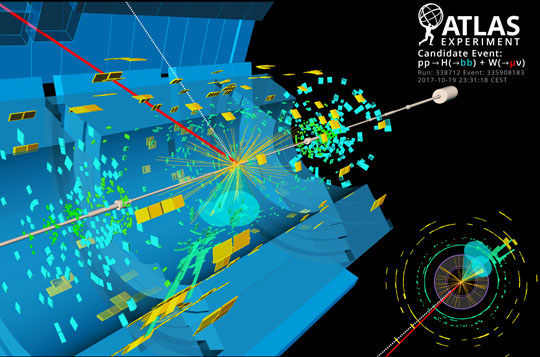The long-awaited split
Freiburg, Aug 29, 2018
A great success for science: Researchers at the ATLAS and CMS experiments located at the world's largest particle accelerator Large Hadron Collider (LHC) at CERN in Geneva, Switzerland have achieved proof that they have been chasing for six years. They have proven that the Higgs particle breaks down into two bottom quarks. Prof. Dr. Karl Jakobs, experimental particle physicist at the University of Freiburg, is the scientific director of the ATLAS experiment. Rimma Gerenstein asked the experts what the discovery means for the previous assumptions of physics.

The Higgs particle breaks down into two bottom quarks (blue, cone-shaped). Photo: CERN
Mr. Jakobs, researchers were able to observe for the first time how a Higgs boson was broken down into two bottom quarks. What exactly does that mean?
Karl Jakobs: During the discovery of the Higgs particle in 2012, only decays of the Higgs particle were observed in heavy, so-called W bosons, Z bosons and photons. These are particles that impart a certain force; they are, so to speak, the transmitters of the electromagnetic and weak interactions. The standard theory of particle physics, however, also predicts that the Higgs field is responsible for the mass of the building blocks of matter - that is, for the mass of quarks and leptons. This aspect of the theory has so far been completely untested. This step has now succeeded through the recently observed decays in two bottom quarks - along with observed interactions with the top quark and the tau lepton.
The detection of the Higgs particle six years ago was a sensation for the world of science. Does the latest discovery fall into the same category?
Of course, the discovery of the particle itself should be viewed as more spectacular. However, by demonstrating this decay, we have come a huge step closer in measuring and understanding its properties. It's a huge milestone! The decay into two bottom quarks is the most common decay of the Higgs particle. According to theory, it occurs with a probability of 58 percent. Nevertheless, it has taken six years since the discovery to establish it beyond a shadow of a doubt. This is mainly because there are many other processes that produce bottom quarks, and at much higher rates. So we had to develop a very sophisticated analysis and record many collision data to establish the signal.

"By discovering the Higgs particle and observing its decay in bottom quarks, particle physics is by no means over," says Karl Jakobs. Photo: Jürgen Gocke
How have you and your colleagues responded to this discovery?
As I already mentioned: It is a huge step forward and a great success for the experiments ATLAS and CMS and for CERN, which has to be celebrated! I remember very well that in the planning phase of the experiment, based on simulation studies, it was not clear whether this verification would actually work. The fact that it did shows on the one hand the high performance of the CERN accelerator, the LHC, which has supplied a large amount of data, as well as the high performance of the experiments, which have recorded the high data volume very efficiently and could provide excellent measurements of the particle signatures. In addition, the development of novel analysis methods was important. As always in particle physics, it has been a great joint effort.
How will these new insights be applied?
Particle physics is by no means complete with the discovery of the Higgs particle and the observation of its decay in bottom quarks. We have other important questions to answer, including, for example, the question of the nature of dark matter in the universe - or, more generally, the question of physics beyond today's standard theory. There are two main thrusts that we need to follow over the coming years. In addition to the direct search for new particles at the LHC, the properties of the Higgs particle must be measured with greater precision. It is enormously important to test the predictions of the theory about its decays and to check if there are any significant deviations. That could play a key role in the discovery of new physics.
Karl Jakobs’ view of his role as scientific director of the ATLAS experiment
Article about dark matter in the research magazine uni’wissen

